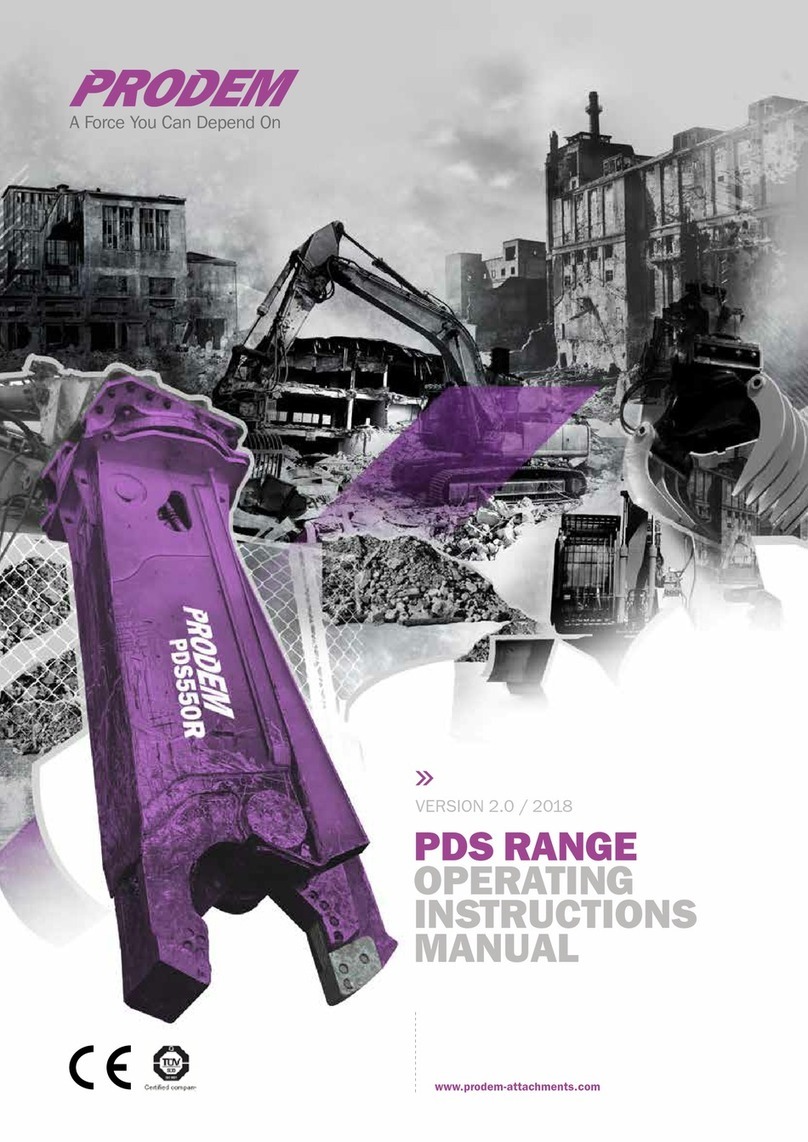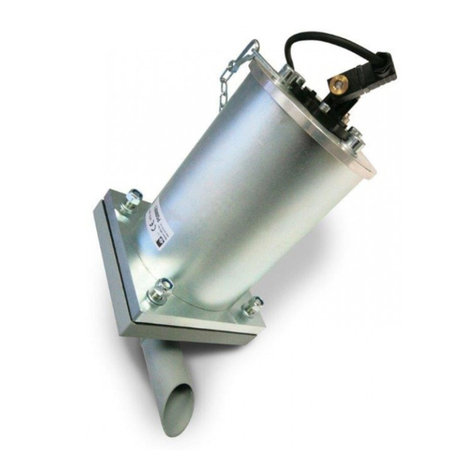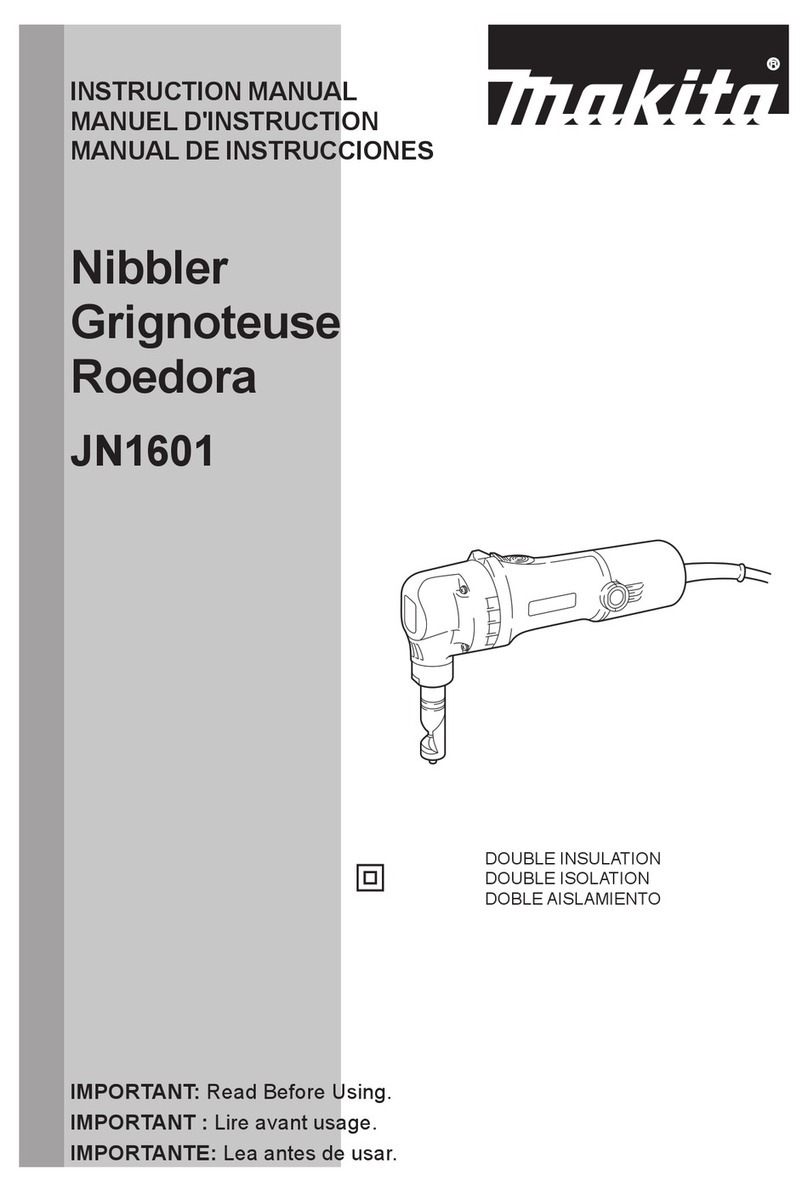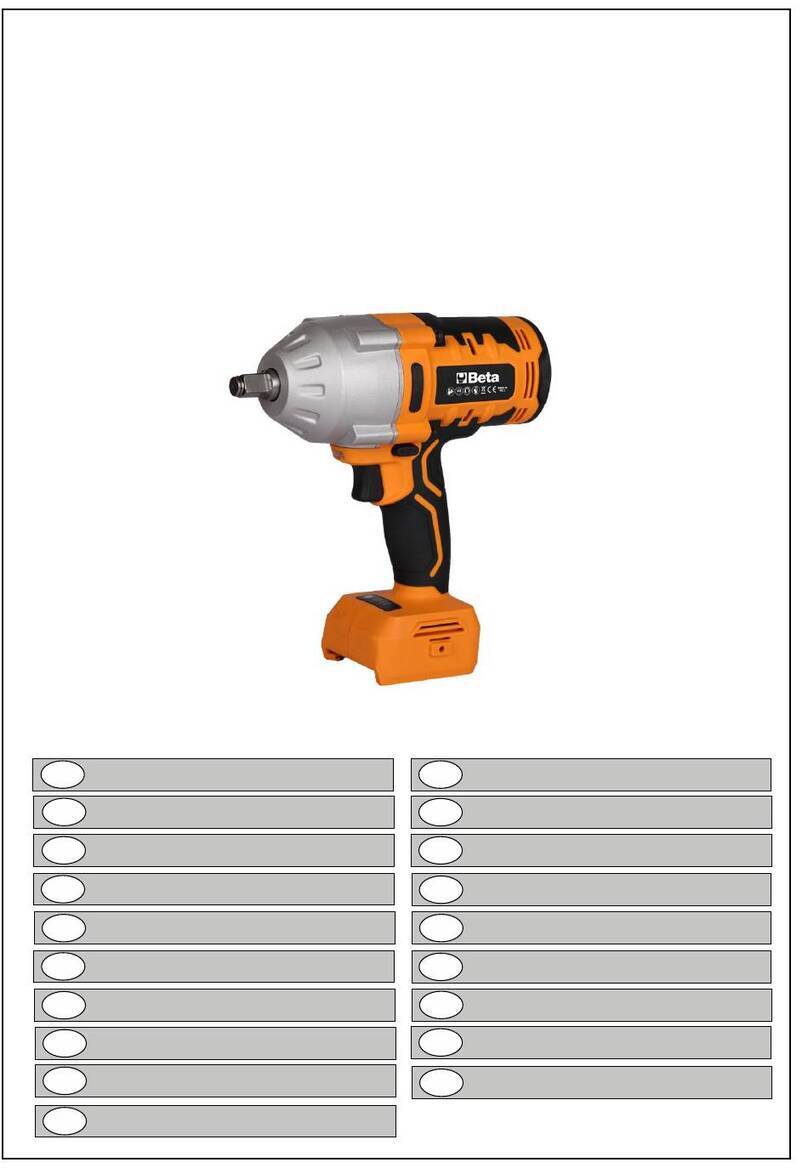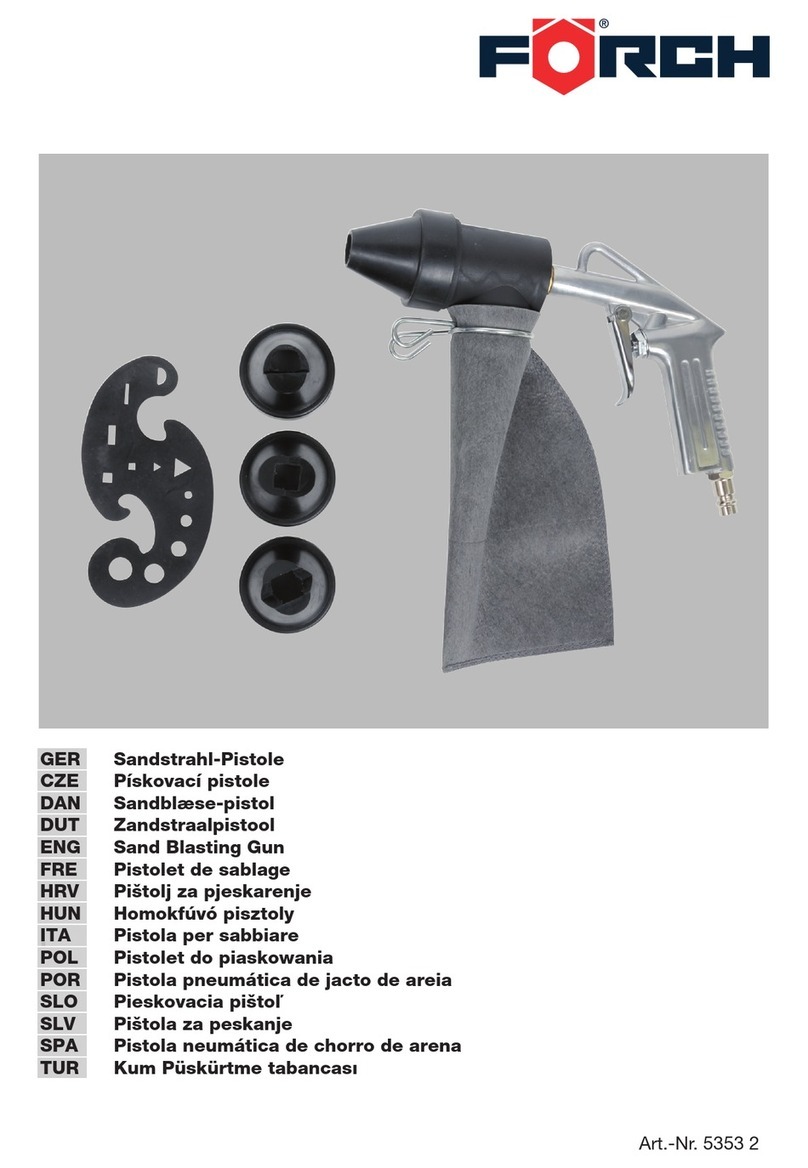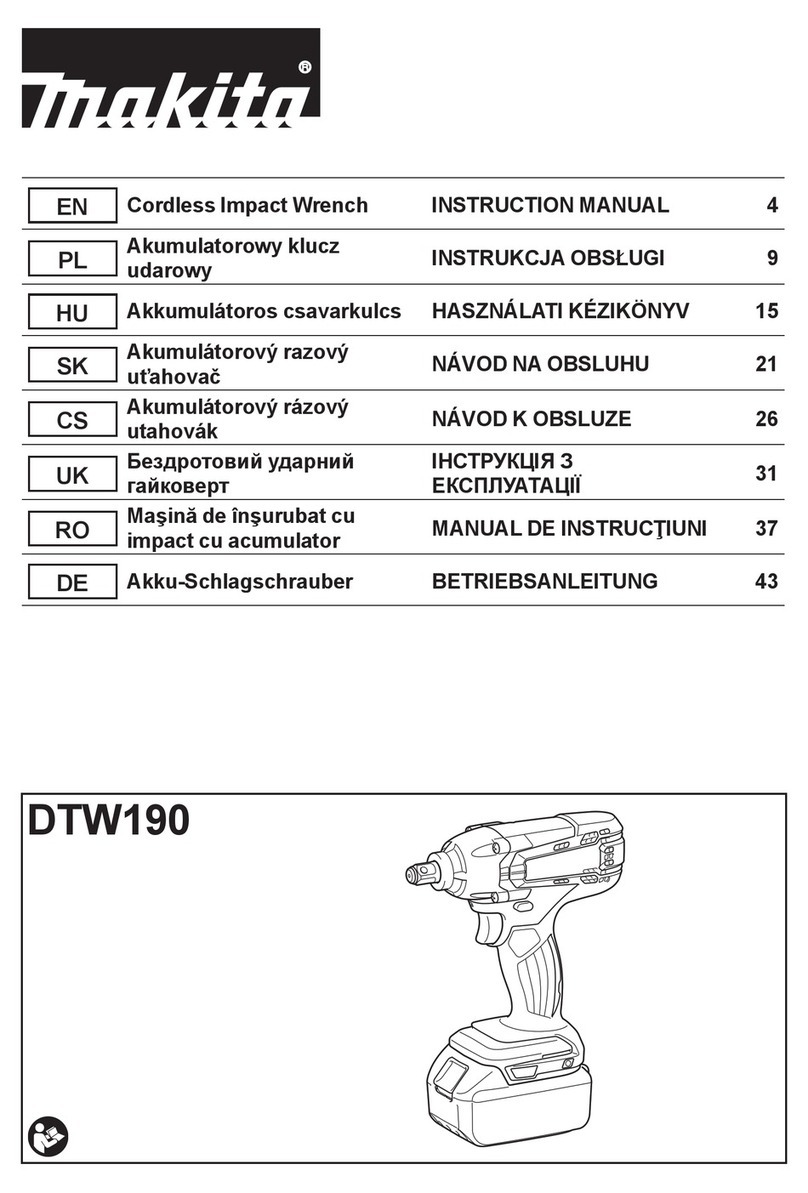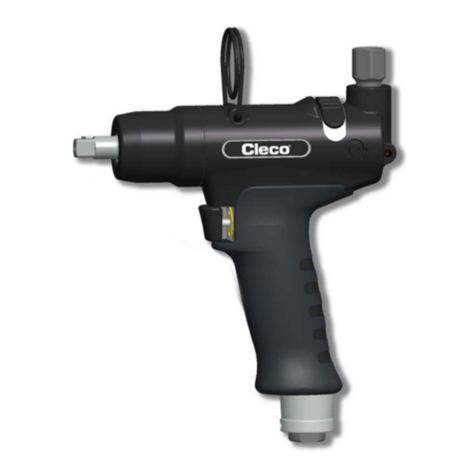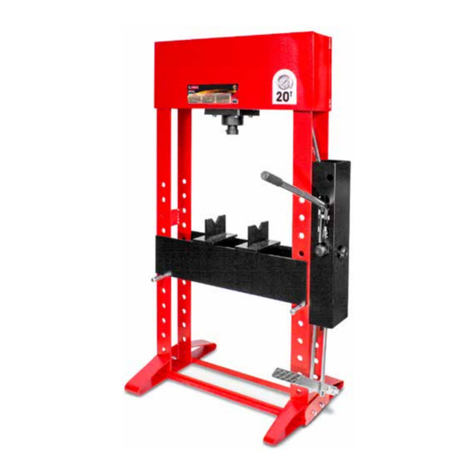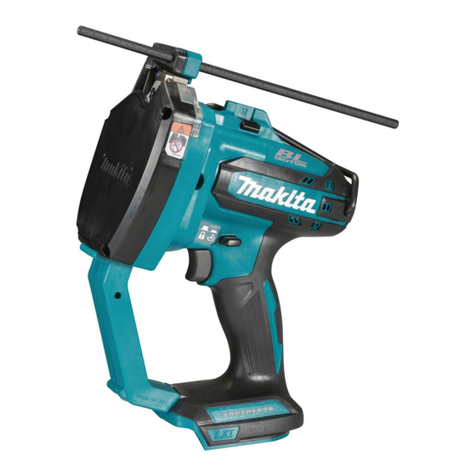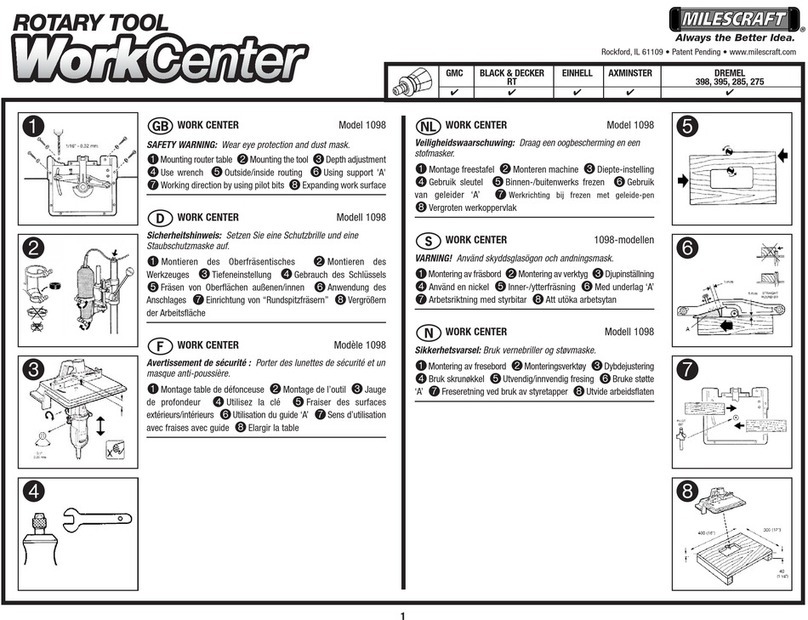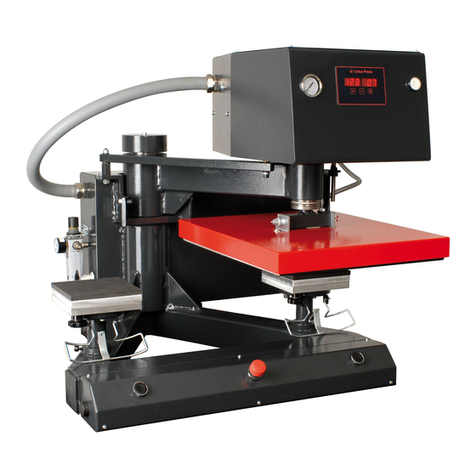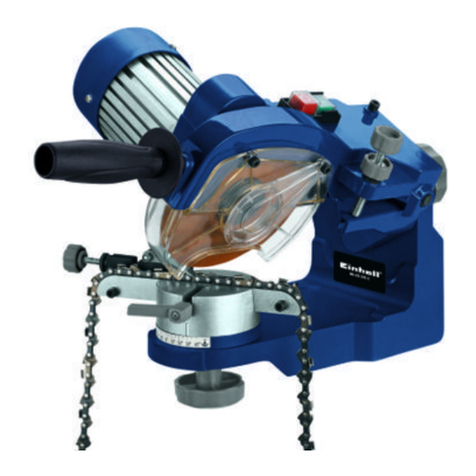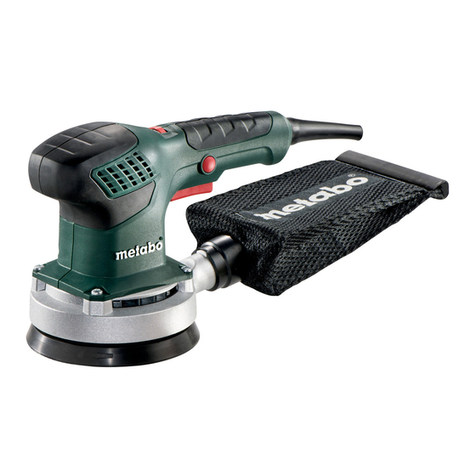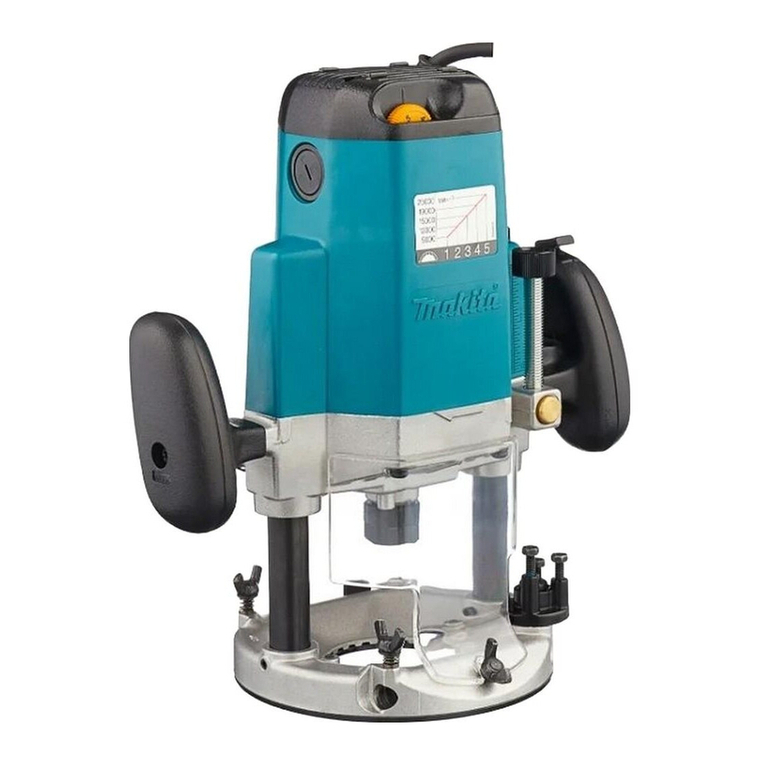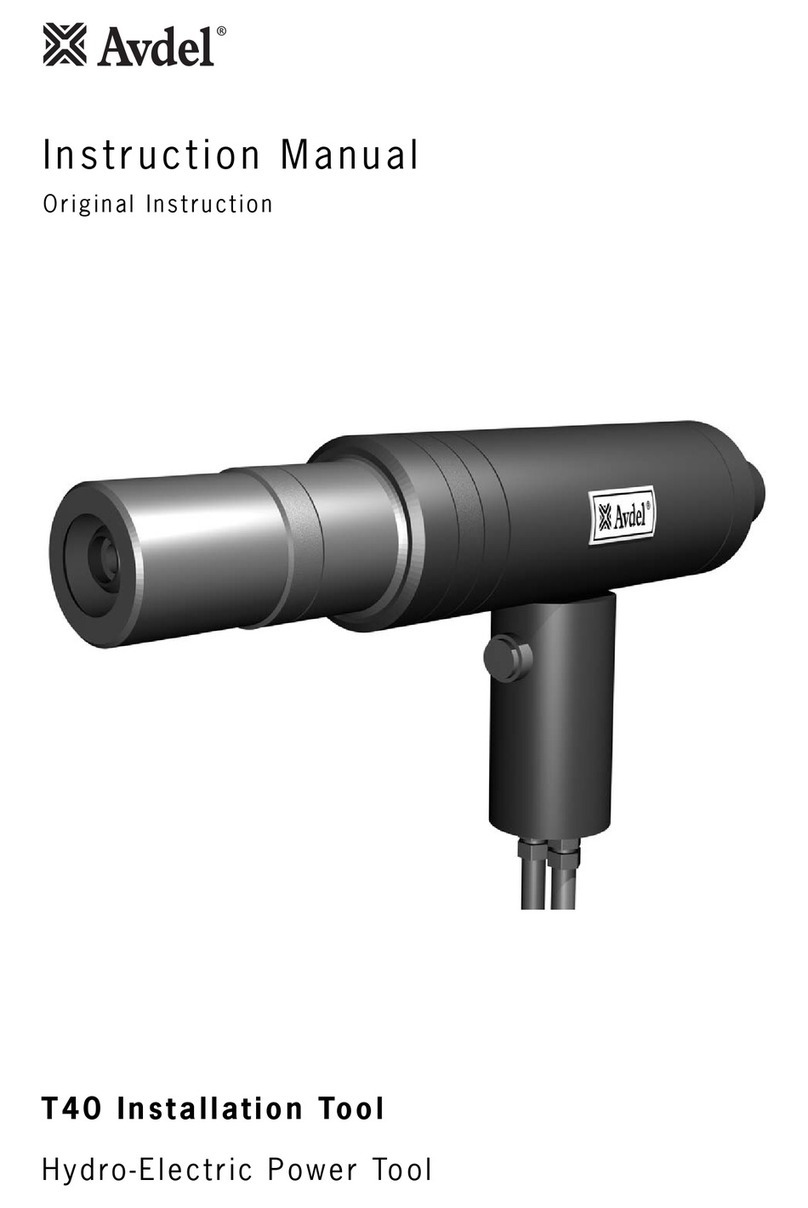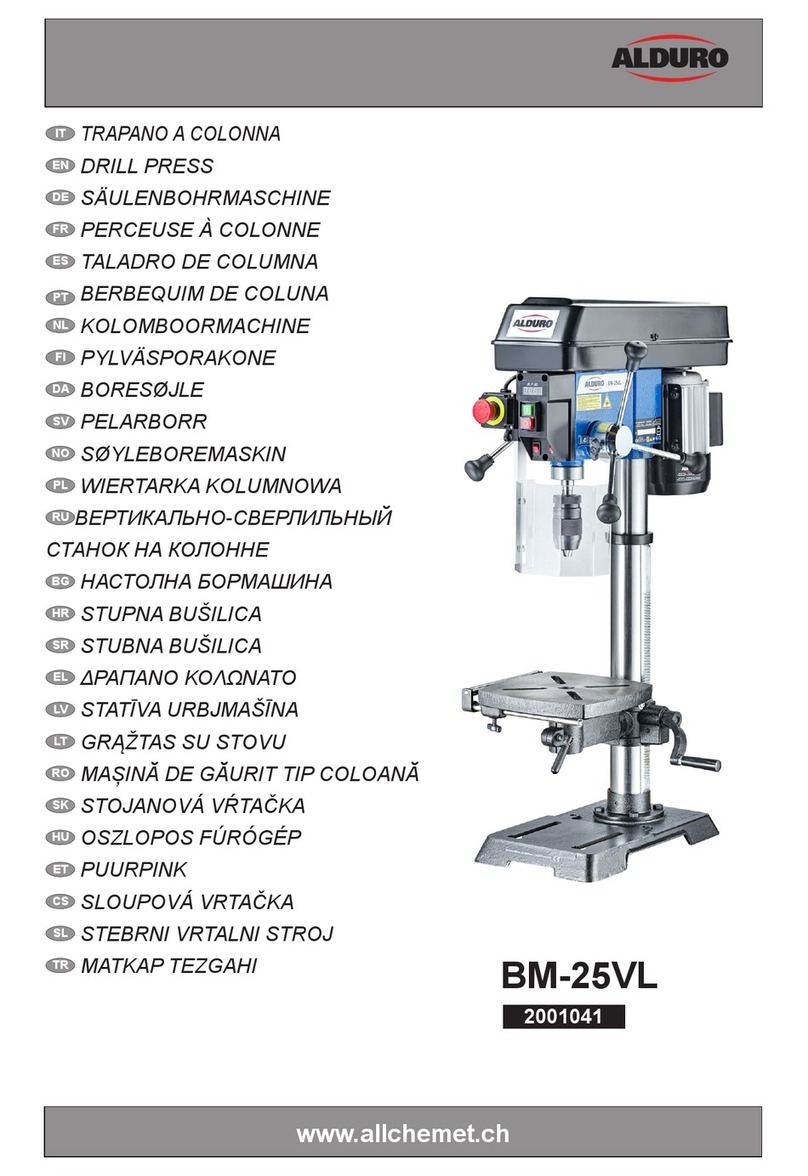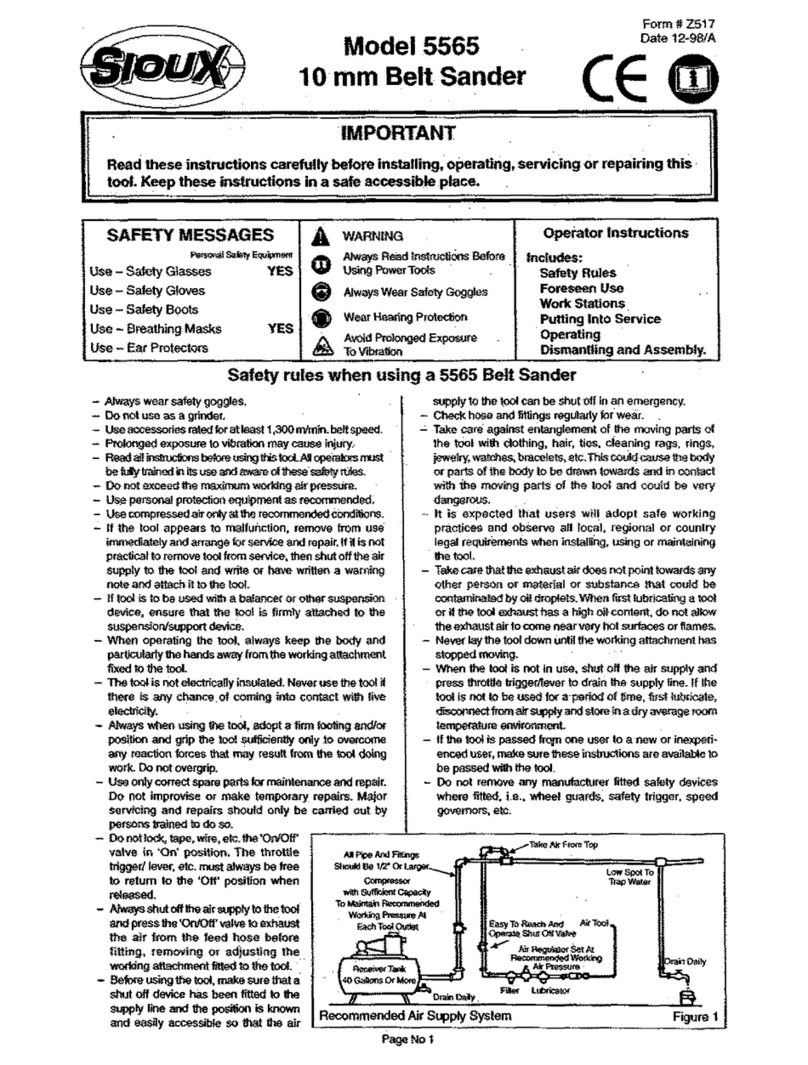PRODEM PRB008 User manual

Operation and Maintenance Manual
Hydraulic Hammers
PRB008
PRB 010
PRB 020
PRB 030
PRB 040(H)
PRB 050
PRB 060
PRB 100
PRB 150
PRB 170
PRB 200
PRB 250
PRB 300
PRB 400
PRB 500
PRB 700
Documents No.: AA099-0018
Revision Date: 2016-12-05
©PRODEM

- 2 -
FOREWORD
WARNING!
It is very important for you to read and understand this manual before operating and to keep
the instructions provided herewith. Never fail to follow the instruction related to safety.
This manual contains instructions and information on safe and correct use of PRODEM hydraulic hammers.
Please read and understand this manual before operation, inspections and maintenance of the hydraulic
hammer.
Keep this manual with your equipment all the time for your quick and easy reference, and read it
regularly.
Do not operate the hydraulic hammer until you have been trained in the use of all operating controls and
understand the hydraulic hammer operation.
Get a replacement manual from PRODEM dealer if you lost it.
If you transfer the hydraulic hammer to the other, do transfer this manual as well.
The figures in this manual are for better understanding and may not correspond exactly to the hydraulic
hammer. For exact shape, refer to the parts list or ask PRODEM.
For the purpose of constant product improvement, some parts of this manual may be changed. If you
found the parts unclear or not corresponding to the hydraulic hammer, call and consult PRODEM dealer
or service center
Important information on safety is described in the safety information chapter of this book. Be
familiarized with the instructions on the safe operation and observe the instructions before and during
operation
Injury, death or damage caused by unauthorized product modifications and operation under unallowed
application will not be responsible by PRODEM. Consult PRODEM for such modifications and
applications.
Use PRODEM genuine parts. PRODEM takes no responsibility for damages caused by use of non-
PRODEM spare parts.
For warranty, we refer you to the warranty conditions provided separately.
We always exert all our efforts for your satisfaction, and promise you quick and constant service.
We thank you for using PRODEM hydraulic hammer and wish you a good luck in every your job,
Jul. 2010
PRODEM
Copyright © 2010 PRODEM. All rights reserved.
This manual is copyrighted by PRODEM with all rights reserved in accordance with prevailing law. It is positively
prohibited to use or reproduce its contents in whole or in part without prior written permission.

- 3 -
TABLE OF CONTENTS
FOREWORD............................................................................................................................................................ 2
1. Safety Information................................................................................................................................................ 6
1.1 Basic Safety Information .............................................................................................................................. 7
1.2. Preparation for safe operation..................................................................................................................... 8
1.3. Safety information on safe operating........................................................................................................... 9
1.4. Safety information on maintenance ............................................................................................................. 9
2. Warranty ............................................................................................................................................................ 10
3. Product information............................................................................................................................................ 11
3.1. Configuration of the PRODEM hydraulic hammer ..................................................................................... 11
3.2. Information for ordering and service.......................................................................................................... 12
3.3. Markings and labels .................................................................................................................................. 13
4. Technical specifications...................................................................................................................................... 15
5. Installation.......................................................................................................................................................... 18
5.1. Carrier requirements ................................................................................................................................. 18
5.2. Attaching the mounting adapter................................................................................................................. 19
5.3. Mounting the hydraulic hammer on the carrier .......................................................................................... 19
5.4. Connecting the hydraulic lines of the hammer........................................................................................... 21
5.5. Connection ports of the hammer ............................................................................................................... 22
5.6. Dismounting the hydraulic hammer from the carrier.................................................................................. 23
5.7. Fitting / removing the chisel....................................................................................................................... 23
5.8. Adjusting the pressure-adjusting valve ...................................................................................................... 25
5.9. Adjusting impact rate – 2-speed selection ................................................................................................. 26
5.10. Anti-Blank-Blow (Auto-Stop) function....................................................................................................... 27
5.11. Inspection after installation ...................................................................................................................... 28
6. Operating the hydraulic hammer........................................................................................................................ 29
6.1. Selecting the right chisel ........................................................................................................................... 29
6.2. Correct working methods .......................................................................................................................... 30
7. Maintenance ...................................................................................................................................................... 33
7.1. General Information................................................................................................................................... 33
7.2. Care and maintenance schedule............................................................................................................... 34
7.3. Hydraulic oil............................................................................................................................................... 34
7.4. Grease ...................................................................................................................................................... 36
7.5. Gas............................................................................................................................................................ 37
7.5.1. Checking and charging the gas in the back-head................................................................................... 37
7.5.2. Checking and charging the gas in the accumulator................................................................................ 39
7.6. Chisel, wear bushings and chisel pins....................................................................................................... 40
7.7. Bracket and Adapter..............................................................................................................................- 43 -
7.8. Screw tightening....................................................................................................................................- 43 -
7.9. Replacing the through bolts...................................................................................................................- 45 -
7.10. Checking the bottom of the piston.......................................................................................................- 45 -

- 4 -
7.11. Storage of the hammer ........................................................................................................................- 46 -
8. Troubleshooting .............................................................................................................................................- 47 -
* Specifications and features presented in this document are subject to change without notice.

- 5 -
Blank page

- 6 -
1. Safety Information
This manual describes the correct use of the product and basic safety instructions. Important instructions in
this manual are marked with this symbol . When you see this symbol in this manual or stickers on the
product, you must be alert to the possibility of personal injury or death. Be sure to observe the instruction in
the safety message.
The safety messages in this manual do not describe all the possibilities that could cause personal injury,
death or damage to the product. These safety messages are intended to provide basic instructions for safe
operation and service.
Although this manual does not cover all the possible situations, it is the operator’s responsibility to observe
the safety instructions and regulations.
Remember! Safety is up to you.
Safety Alert Symbol
The Safety Alert Symbol represents that
ATTENTION
is involved.
If you see the mark in this manual or on the products, never fail to read and
observe the instructions for safe operation.
Signal Words
The words “DANGER”, “WARNING”, “CAUTION” and “IMPORTANT” appeared with the above Safety Alert
Symbol indicate degree of risk of hazards or unsafe practices. All four degrees of risk indicate that safety is
involved. Observe precautions indicated whenever you see the Safety Alert Symbol, no matter which
signal word appears next to the “Exclamation Point” symbol.
DANGER!
Indicates imminent hazard of a situation that, if not avoided, is very likely to cause
death or extremely serious injury. It may also be used to alert against product that
may exploded or detonate if handled or treated carelessly.
WARNING!
Indicates potential of a hazardous situation that, if not avoided, could result in serious
injury or death. It may also be used to alert against a highly unsafe practice.
CAUTION!
Indicates potential of a hazardous situation that, if not avoided, could result in minor
or moderate injury. It may also be used to alert against a general unsafe practice.
IMPORTANT!
Indicates potential of damages that, if not avoided, could caused to the product or
shorten the product life.

- 7 -
1.1 Basic Safety Information
WARNING!
The following instructions are those that should ALWAYS be observed in operation of
construction equipment.
Know yourself
Operators and service personnel must wear appropriate safety
equipment, including hearing protection, respirator, hardhat, safety
shoes, eye protection, heavy gloves etc, as required.
Note: The wearing of loose clothing or any accessories such as neckties
,
scarves, untied shoe laces, rings, wrist watches or long hair could cause
personal injury or death.
Always use the proper tools for inspection or maintenance work, which
must only be carried out after ensuring that the equipment has been
stopped completely, and it is placed suitably in a safe place.
Figure 1
Know your equipment
Before installation or operation of the hammer, the operator and
maintenance personnel must read and understand the safety messages
,
operation manual and service instructions.
Only the operator who has been trained and qualified to operate the
carrier and hammer should do so. Be skilled and knowledgeable in all
operational and technical aspects of the carrier and hammer.
Figure 2
Know the work site
Before operating the hammer, check the area of work site for any
unusual conditions that could be dangerous,
and prepare the appropriate
warnings for safe work
ing. Be careful, particularly when working in the
vicinity of electric power lines, gas pipes or other buried services.
Pay particular attention to other workers, bystanders and other
machinery that may pass by near to the work site. Immediately stop
operation of the hammer if personnel enter the danger area.
Figure 3

- 8 -
Know the rules
Everybody who operates or maintains the equipment should know the
meaning of the rules and laws in terms of handling the equipment. Use
the hammer in accordance with all regulations regarding construction
practice and public safety.
For emergency use, keep the fire extinguisher and the first-aid case in
the operator’s cab.
Figure 4
1.2. Pre aration for safe o eration
Some prior checks and scheduled maintenance must be performed on installing a new hydraulic hammer.
The hydraulic hammer should only be mounted on a carrier with sufficient load capacity.
In case of using a quick coupler (hitch), determine the total weight including the quick coupler.
Carriers below this weight class will not provide the required degree of stability and could even fall over
during hammer use, causing personnel injury or machine damage. Carriers above this weight class may
apply excessively high mechanical loads to the hammer.
Make sure the hammer is compatible and match in capacity with carrier hydraulic systems.
To protect the operator from injury due to flying rock splinters, the operator’s cab should be equipped
with a protective shield or splinter guard. For information on the cab protector, consult carrier
manufacturer or PRODEM dealer.
Mounting the hydraulic hammer requires the presence of an assistant, who must be instructed by the
carrier driver. The carrier driver and assistant should agree beforehand on clear hand signals.
To avoid equipment damage, follow the carrier maintenance schedule before operating the hammer.
Check the hammer for wear, getting loose, breakage or crack. Do not operate in case any damages or
failure is found.
Recommended carrier weight (in tonne) for hammer models:
Hammer Model Carrier class
(Standard) Hammer Model Carrier class
(Standard)
PRB008
0.
7
~ 1.
0
PRB
15
0
12 ~ 16
PRB010
0.7 ~
1.2
PRB170
1
8
~ 2
2
PRB
02
0
1.0 ~ 2.0
PRB
20
0
20
~ 2
4
PRB
03
0
1.5 ~ 3.0
PRB
25
0
20 ~ 26
PRB
04
0(H)
2.5 ~ 4.5
PRB
30
0
26 ~ 32
PRB
05
0
4.0 ~ 6.0
PRB
40
0
32 ~ 40
PRB
06
0
6.0 ~ 8.0
PRB
50
0
40 ~ 60
PRB100
8.0 ~ 12
PRB7
0
0
6
0 ~
110

- 9 -
1.3. Safety information on safe o erating
Always operate the hammer from the operator’s seat in the carrier cab, and also close the splinter guard
on the driver’s cab during hammer operations.
The hydraulic hammer must not be used for disallowed applications. Refer to Section “6.2. Correct
working methods” of this manual for instructions on how to handle the hydraulic hammer, and
applications for which the hydraulic hammer is unsuitable and must not be used.
Stop the operation if an abnormal noise or vibration is detected during the operation. Check the carrier
and hammer.
Never use the hammer in or underwater unless compressed air is supplied to the hammer. Refer to
Section “6.2. Correct working methods for details”.
1.4. Safety information on maintenance
Always follow the instructions described in this manual when performing maintenance work on the hammer.
Pay careful attention to all relevant safety regulations. Most accidents occur when the instructions are
not observed.
Maintenance work should be performed with the carrier completely stopped, the stop valves shut off.
The carrier must be on firm and flat ground with all the control levers switched off.
Use only the lifting points provided and sufficiently strong lifting equipment when lifting the hammer.
Do not start maintenance on the hammer until it has cooled because the hammer is heated up during
operation. Some components, for example, chisel (tool), valve, piston or hydraulic connection parts
become very hot.
The hydraulic oil may be very hot and may cause severe scald. Before disconnecting hydraulic lines,
bleed all hydraulic pressure in the lines. And, always relieve tank pressure of the carrier.
Oil spouted out from the crack or small hole on hydraulic system can penetrate the skin and cause
serious injury. Therefore, be sure that all the connections are tight and pipes and hoses are in good
condition. Use a sheet of cardboard or wood to search for suspected oil leaks.
To avoid an explosion and equipment damage, use only pure nitrogen gas (99.8% or over) in the gas
chamber of the back-head and accumulator.
Only the proper tools should be used for maintenance. Use of improper tools may cause personal injury,
or damage to the hammer.
Oily, greasy ground may be very slippery. Collect any oil and grease, and dispose it correctly for safety
and environment.
Keep personnel away from the hammer while servicing the chisel, gas chambers or hydraulic system.
Unauthorized alteration on the hammer may cause the hammer serious troubles or reduce hammer life
and performance. These cases cannot be guaranteed by PRODEM.

- 10 -
2. Warranty
The warranty period for PRODEM hydraulic hammers is provided as below.
Base warranty
PRODEM’s products to be well-made, durable and of good material are warranted for twelve (12)
months from the date of delivery of such new products to the actual and original buyer, but no more than
eighteen (18) months from the date of shipment from PRODEM’s factory for the failure by the reason of
defective material or poor workmanship, except wear and sealing items such as stipulated in the ‘Limited
Warranty’.
Limited warranty
1. Sealing parts
Sealing parts such as seals, O-rings and diaphragms installed in new products are warranted for six (6)
months from the date of delivery to actual and original buyer, but no more than twelve (12) months
from shipping date from PRODEM’s factory.
2. Wear parts
Wear items listed herein below are warranted for three (3) months from the date of delivery to actual
and original buyer, but no more than eighteen (18) months from shipping date from PRODEM’s factory.
chisel, tooth, bush, pin, ring, plug, fitting, fastener, rubber, hose, wearing plate, damper, polyurethane
form, shim
3. Through bolts
Through bolts are warranted for six (6) months from the date of delivery to actual and original buyer,
but no more than eighteen (18) months from shipping date from PRODEM’s factory.
4. Spare parts
Spare parts other than those indicated as wearing parts or consumable parts will be warranted for
three (3) months after the date of delivery to the actual or original buyer, but within eighteen (18)
months from the shipping date from PRODEM’s factory. PRODEM adopt whichever period comes first
out of two conditions.
5. Multi-shift work
PRODEM guarantee the defect and failure caused by PRODEM’s fault under the normal condition of
work which means that customer should comply with maintenance schedule, precautions and 8 hours
(day shift) working a day. In case that the breaker is operated with multi-shift (day and night shift)
working, the warranty period will be cut by half.
Exclusion of warranty
PRODEM does not take responsibility for the results of use not recommended in this manual and
specifically for:
1. Problems caused by incorrect operation or using to non-recommended application
2. Problems caused by improper handling or storage
3. Problems caused by improper maintenance
4. Problems caused by using non-genuine parts
These exclusions apply to damage to the hammer, the carrier, and associated equipment and personnel
injury.
For further information, refer to the “Warranty & service guide line” provided by PRODEM.
PRODEM reserve the right to modify the design or change the specifications without prior notice for the
improvement of performance or quality.

- 11 -
3. Product information
3.1. Configuration of the PRODEM hydraulic hammer
The PRODEM hydraulic hammer has the following main components or assemblies
1
2
3
4
5
6
7
9
10
11
12
13
14
15
16
17
18
19
20
21
8
1. Cylinder
2. Piston
3.
Valve
4. Cylinder bush
5. Accumulator
6. Front-head
7. Chisel bush
8
Thrust ring
9. Chisel pins
10.
Front bush
11.
Chisel
12.
Back-head
13.
Minimess coupling
14.
Through bolts
15.
Front-head nuts
16.
Back-head nuts
17.
Lower damper
18.
Wear plates
19.
Support damper
20.
Upper damper
21.
Bracket
The graphic shows only a general view of the main components, the actual details may vary on different
models of hydraulic hammer.
The hammer is hydraulically operated equipment, and can be used on any carrier that meets the necessary
hydraulic and mechanical installation requirements (Refer to Section “4. Technical specifications”).

- 12 -
3.2. Information for ordering and service
The equipment serial number is marked with the type and serial number on the nameplate (refer to Section
“3.3. Markings and labels”. It is important to make correct reference to the serial number of the hammer
when making repairs or ordering spare parts. Identification by serial number is the only proper means of
maintaining and identifying parts for specific hammers.
Model Code and Serial Number
( : Number, : Alphabet )
Model code:
PRB
-
Serial Number :
-
Example: PRB150-BA Example : 15 - H001
DR: Model prefix
B: Product group code (B: breaker)
15: Model number
150: 15 tonne carrier class
B: Bracket version
N: side plate
B: silenced
A: Mounting type
A: adapter mounted type
D: direct mounted type
L: backhoe loader mount type
15 : Model number
H : Factory code
001: Serial number
Available bracket version
Hammer model code:
008
010
020
030
040
050
060
100
150
170
200
250
300
400
500
700
NA:
Adapter mounted side
-plate bracket
NL:
Loader mounted side-plate bracket
BA:
Adapter mounted silenced bracket
SLA:Skid steer loader mounted bracket
Available features (standard & option)
Hammer model code:
008
010
020
030
040
050
060
100
150
170
200
250
300
400
500
700
2-speed control
– – – – – – – – ALL
ALL
ALL
ALL
ALL
ALL
ALL
ALL
Anti-blank blow
– – – – – – – – – –ALL
ALL
ALL
ALL
ALL
ALL
Auto-greasing kit
– – – – – – – – all
all
all
all
all
all
all
all
Note:
Depending on bracket type;
BOLD: standard features for the designated bracket version
Italic: optional features for the designated bracket version
–: not available

- 13 -
3.3. Markings and labels
This figure shows only a general view. Details may vary on different hammer models.
1. PRODEM Logo
2. Name plate (with CE label)
3. Greasing Port
Indicates grease point. Apply grease at the interval
prescribed.
EVERY 2 HOURS
4. Lifting Point
Indicates the hooking points used when lifting the
hammer
2
3
4
1
5
67
8

- 14 -
Pay special attention to the marks and labels related to safety such as follows.
5. General safety
6. Stay clear
Indicates the distance that must be kept from the
breaker, to be safe from the flying rock splinter
7. Safety on gas charging in Back-head
8. Safety on gas charging in Accumulator

- 15 -
4. Technical s ecifications
PRB008 / 010 / 020 / 030 / 040(H)
Model PRB008 PRB010 PRB020 PRB030 PRB040(H)
Bracket version
1)
NA
BA
NA
BA
NA
BA
NA
BA
NA
BA
Working weight
2)
kg 79 80 116
116
116
116
142
144
211
243
Weight w/o mounting adapter kg 69 70 98 98 98 98 124
126
181
213
Overall length
3)
mm 1,070
1,065
1,207
1,215
1,207
1,215
1,242
1,257
1,390
1403
Required oil flow rate l/min 15 ~ 30 15 ~ 25 20 ~ 35 20 ~ 35
30 ~ 50 /
50~75(H)
Operating pressure bar 100 ~ 130 100 ~ 130 100 ~ 130 100 ~ 130 110 ~ 140
Input power (max.) kW 6.5 5.4 7.6 7.6 11.7 / 17.5(H)
Impact rate
Low speed mode bpm n/a n/a n/a n/a n/a
High speed mode bpm 550 ~ 1,300
700 ~ 1,200
700 ~ 1,200
550 ~ 1,000
550 ~ 1,000
Impact Energy
4)
Low speed mode Joule
n/a n/a n/a n/a n/a
High speed mode Joule
110 180 200 300 450
Tool shank diameter mm 42 45 45 50 58
Applicable carrier weight
Optimal range tonne
0.7 ~ 1.0 0.7 ~ 1.2 1.0 ~ 2.5 1.5 ~ 3.0
2.5~4.5/4.0~6.0(
H)
Available range tonne
0.6 ~ 1.5 0.7 ~ 2.5 1.0 ~ 4.0 1.5 ~ 4.5
2.5~6.0/2.5~8.0
(
H)
Gas charging pressure
Back-head bar 8~10 8~10 8~10 8~10 10~12
Accumulator bar n/a n/a n/a n/a n/a
Hydraulic piping
Line size; min. internal diameter
mm (in)
9.5 (3/8) 9.5 (3/8) 12 (1/2) 12 (1/2) 12 (1/2)
Acceptable back pressure
5)
bar 15 15 15 15 15
Hose connection ports for
Oil supply(IN) & return(OUT)
BSP 3/8”
O-Ring boss female
BSP 1/2”
O-Ring boss female
Pressure relief (min.) bar 30 bar higher than measured maximum operating pressure
Acceptable Hydraulic oil
Operating temperature °C -20 ~ +80 -20 ~ +80 -20 ~ +80 -20 ~ +80 -20 ~ +80
Viscosity cSt 1,000 ~ 12
1,000 ~ 12
1,000 ~ 12
1,000 ~ 12
1,000 ~ 12
Note:
1) For the specifications of other versions of bracket, contact your PRODEM dealer or service.
2) Including standard tool, standard mounting adapter and spacers but excluding hydraulic hoses, fittings and
mounting pins.
3) Measured from the tool tip of the standard tool to the top of the breaker excluding standard mounting adapter.
4) Measured in accordance with the certified test procedure which comply with the AEM Tool Energy Rating for
hydraulic breakers.
5) The maximum allowed oil pressure at the breaker's connection point to the return line (measured statically
without the breaker)

- 16 -
PRB050 / 060 / 100 / 150 / 170
Model PRB050 PRB060 PRB100 PRB150 PRB170
Bracket version
1)
NA
BA
NA
BA
NA
BA
BA BA
Working weight
2)
kg 330
314
455
468
549
552
1,040 1,341
Weight w/o mounting adapter kg 284
268
385
398
479
482
892 1,121
Overall length
3)
mm 1,674
1,682
1,916
1,933
2,049
2,066
2,375 2,642
Required oil flow rate l/min 35 ~ 65 45 ~ 90 60 ~ 110 80 ~ 140 110 ~ 170
Operating pressure bar 130 ~ 170 130 ~ 170 140 ~ 180 140 ~ 180 160 ~ 180
Input power (max.) kW 18.4 25.5 42 51
Impact rate
Low speed mode bpm n/a n/a n/a 380 ~ 700 350 ~ 600
High speed mode bpm 550 ~ 1,000
520 ~ 1,000
500 ~ 1,000
550 ~ 850 500 ~ 750
Impact Energy
4)
Low speed mode Joule n/a n/a n/a 2,500 2,800
High speed mode Joule 700 1,000 1,350 2,150 2,200
Tool shank diameter mm 68 80 105 117
Applicable carrier weight
Optimal range tonne
4.0 ~ 6.0 6.0 ~ 8.0 8.0 ~ 12 12 ~ 16 18 ~ 22
Available range tonne
3.5 ~ 8.0 5.0 ~ 11 7.0 ~ 15 12 ~ 20 14 ~ 24
Gas charging pressure
Back-head bar 15~17 15 ~ 17 15 ~ 17 15 ~ 17 15 ~ 17
Accumulator bar n/a n/a n/a n/a 60
Pressure adjust valve setting
(No. of turns open from full-close)
n/a n/a n/a n/a 1.5~2.0
Hydraulic piping
Line size; min. internal diameter
mm (in)
12 (1/2) 19 (3/4) 19 (3/4) 19 (3/4) 25 (1)
Acceptable back pressure
5)
bar 15 15 15 15 10
Hose connection ports for
Oil supply(IN) & return(OUT)
BSP 1/2”
O-Ring boss
female
BSP 3/4”
O-Ring boss female
BSP 1”
O-Ring boss
female
Pressure relief (min.) bar 40 bar higher than measured maximum operating pressure
Acceptable Hydraulic oil -20 ~ +85
Operating temperature °C 1,000 ~ 10
-20 ~ +85 -20 ~ +85 -20 ~ +85 -20 ~ +85
Viscosity cSt 35 ~ 65 1,000 ~ 10
1,000 ~ 10
1,000 ~ 10
1,000 ~ 10
Note:
1) For the specifications of other versions of bracket, contact your PRODEM dealer or service.
2) Including standard tool, standard mounting adapter and spacers but excluding hydraulic hoses, fittings and
mounting pins.
3) Measured from the tool tip of the standard tool to the top of the breaker excluding standard mounting adapter.
4) Measured in accordance with the certified test procedure which complies with the AEM Tool Energy Rating for
hydraulic breakers.
5) The maximum allowed oil pressure at the breaker's connection point to the return line (measured statically
without the breaker)

- 17 -
PRB200 / 250 / 300 / 400 / 500 / 700
Model PRB200
PRB250
PRB300
PRB400
PRB500
PRB700
Bracket version
1)
BA BA BA BA BA BA
Working weight
2)
kg 1,502 1,754 2,400 3,179 3,890 6,376
Weight w/o mounting adapter kg 1,282 1,534 2,100 2,739 3,440 5,510
Overall length
3)
mm 2,760 2,935 3,281 3,531 3,735 4,236
Required oil flow rate l/min 100 ~ 150
130 ~ 180
170 ~ 240
200 ~ 280
230 ~ 330
320 ~ 420
Operating pressure bar 160 ~ 180
160 ~ 180
165 ~ 185
165 ~ 185
165 ~ 185
165 ~ 185
Input power (max.) kW 45 54 74 86 102 130
Impact rate
Low speed mode bpm 340 ~ 550
330 ~ 500
310 ~ 490
330 ~ 450
250 ~ 370
280 ~ 370
High speed mode bpm 440 ~ 700
430 ~ 650
400 ~ 680
420 ~ 600
350 ~ 500
370 ~ 480
Impact Energy
4)
Low speed mode Joule 3,500 4,300 6,100 7,600 10,400 13,000
High speed mode Joule 2,800 3,200 4,200 6,000 7,900 10,000
Tool shank diameter mm 125 135 150 165 180 205
Applicable carrier weight
Optimal range tonne
17 ~ 20 20 ~ 26 26 ~ 32 32 ~ 40 40 ~ 60 65 ~ 85
Available range tonne
16 ~ 25 20 ~ 30 26 ~ 35 32 ~ 45 40 ~ 70 60 ~ 110
Gas charging pressure
Back-head bar 15 ~ 17 15 ~ 17 15 ~ 17 16 ~ 18 16 ~ 18 16 ~ 18
Accumulator bar 60 60 60 60 60 60
Pressure adjust valve setting
(No. of turns open from full-close)
2.0~2.5 2.5~3.0 2.5~3.0 3.0~3.5 3.0~3.5 2.0~2.5
Hydraulic piping
Line size; min. internal diameter
mm (in)
25 (1) 25 (1) 32 (1-1/4)
32 (1-1/4)
32 (1-1/4)
32 (1-1/4)
Acceptable back pressure
5)
bar 10 10 10 10 10 10
Hose connection ports for
Oil supply(IN) & return(OUT)
BSP 1”
O-Ring boss female
BSP 1-1/4”
O-Ring boss female
BSP 1-1/2”
O-Ring boss female
Pressure relief (min.) bar 40 bar higher than measured maximum operating pressure
Acceptable Hydraulic oil
Operating temperature °C -20 ~ +85
-20 ~ +85
-20 ~ +85
-20 ~ +85
-20 ~ +85
-20 ~ +85
Viscosity cSt 1,000 ~ 10
1,000 ~ 10
1,000 ~ 10
1,000 ~ 10
1,000 ~ 10
1,000 ~ 10
Note:
1) For the specifications of other versions of bracket, contact your PRODEM dealer or service.
2) Including standard tool, standard mounting adapter and spacers but excluding hydraulic hoses, fittings and
mounting pins.
3) Measured from the tool tip of the standard tool to the top of the breaker excluding standard mounting adapter.
4) Measured in accordance with the certified test procedure which comply with the AEM Tool Energy Rating for
hydraulic breakers.
5) The maximum allowed oil pressure at the breaker's connection point to the return line (measured statically
without the breaker)

- 18 -
5. Installation
IMPORTANT!
Improper installation can cause serious damage to the hammer and to the carrier. Do not install
the hammer if you are unsure. Contact your PRODEM dealer for more information.
5.1. Carrier requirements
The PRODEM hammer can be installed on any carrier that meets necessary mechanical and hydraulic
installation requirements. Refer to Section “4. Technical specifications” to determine the carrier specification
required.
Check following points when installing the hammer:
Carrier weight:
The hydraulic hammer should only be mounted on a carrier with sufficient load capacity. In case of using
a quick coupler (hitch), determine the total weight including the quick coupler.
Mounting dimension:
To fit the hammer on the carrier, proper mounting adapter must be used. This mounting adapter varies
according to carrier model and should be ordered separately with follows:
Excavator model and year built
Arm(stick) type
PRODEM’s standard mounting adapters are designed to fit most carrier, and parts for fitting, such as
spacers and pins can also be provided.
Hydraulic line:
Check the nominal bore size of the hammer piping lines on the carrier. Both supply and return lines must
have sufficiently large inner diameters. Small line size causes backpressure increase, overheating of oil
or irregular blows.
Hydraulic pressure:
The hydraulic pressure and oil flow of the carrier’s hammer piping should be adequate for operating the
hammer.
The maximum hydraulic pressure of the carrier must be higher than the recommended relief pressure
setting for the hammer. If not, the impact rate of the hammer becomes slow or the hammer does not start
blowing.
Oil flow:
Oil flow, which controls impact rate of hammer, is the most important factor in the hydraulic parameters to
operate hammer with a good performance, and should not only be too low but also be too high.
Insufficient oil flow cause low impact rates, and on the contrary excessive oil flow causes an increase in
the operating pressure and overheating of the oil. If the output of the pump is more than the maximum
acceptable flow of the hammer, a flow control valve is needed.
Oil cooler:
Too low or too high oil temperature reduces the working performance of a hammer. The temperature of
the hydraulic oil shall never exceed 90°C (194°F), maximum allowed limit, which may cause damage to
the hammer as well as the carrier. If the carrier’s oil cooler is too small, either the original cooler should be
replaced with a larger one or an auxiliary cooler must be installed.
For sufficient cooling of oil, return oil from the hammer must run through oil cooler to oil tank.

- 19 -
5.2. Attaching the mounting ada ter
1. Stand the hammer on the flat and stable base or lay the hydraulic hammer on squared beams or a pallet
with the service window of the hammer box facing upwards.
2. Fix the adapter (1) to the hammer box with two screws.
For silenced hammer, insert the upper damper (2) in the hammer box before fixing the adapter.
3. Then fit all screws (3) and tighten to the specified torque. The sizes of screws for different hammer types
are as follows;
PRB008 ~ 030
PRB040 ~ 150
PRB170 ~ 300
PRB400 ~ 700
: 12 mm
: 20 mm
: 30 mm
: 36 mm
3
4
1
2
1. Adapter
2. Upper damper
3. Screw and washer
4. Nuts and washer
(Number of nuts -single or double-
may vary on different hammer
models)
5.3. Mounting the hydraulic hammer on the carrier
DANGER!
While mounting the hammer or removing the bucket, make sure that there are no persons in
the vicinity of the carrier.
When moving the carrier, do not touch any part of the carrier or hydraulic hammer. Keep
hands away from linkage area and pin-bores.
When aligning pin-bores, never put a finger into the bore, align only by sight or with using drift
pin.
Agree with the assistant on clear hand signals.

- 20 -
During hammer mounting, the carrier should only be operated from the operator’s cab.
1. Following the direction of an assistant, carefully move the excavator arm (2) into the adapter (4), until the
bore in the arm is flush with those in the adapter.
2. Insert the arm pin (3).
3. Fit the stop ring (5) to the arm pin (3) and lock by using the bolt and nuts (6).
1. Hydraulic hammer
2. Excavator arm
3. Arm pin
4. Mounting adapter
5. Stop ring
6. Bolt and nuts
4. Lift up the hammer (1) to a proper height.
5. Extend the bucket cylinder (7) until the bore in the link (9) is flush with those in the adapter (4).
6. Insert the link pin (8).
7. Fit the stop ring (5) to the bucket pin (8) and lock by using the bolt and nut (6).
8. Check there are any mechanical difficulties, slacks or incompatibility in manipulating.
5. Stop ring
6. Bolt and nuts
7. Bucket cylinder
8. Link pin
9. Link
This manual suits for next models
16
Table of contents
Other PRODEM Power Tools manuals
